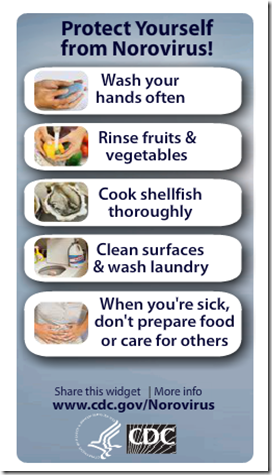Norovirus – Credit HPA
# 6857
Adding to an already busy influenza season, many places across the Northern Hemisphere are dealing with outbreaks of a new strain of Norovirus; dubbed (for its place and year of discovery) Sydney 2012.
Noroviruses, which are often mistakenly called `stomach flu’, are single-stranded RNA viruses that are able to evolve rapidly, so we typically see a new dominant norovirus strain emerge every two or three years.
After exposure and a short incubation period (12-24 hours), the victim usually experiences nausea, frequent vomiting & diarrhea, and stomach pain – and may also experience headache, fever, and body aches.
The illness generally runs its course in 1 to 3 (very long) days, and most people recover. But among those who are aged or infirmed, the virus can take a heavy toll. According to the CDC, each year the norovirus:
- causes about 21 million cases of acute gastroenteritis (inflammation of the stomach or intestines or both)
- contributes to about 70,000 hospitalizations and 800 deaths, mostly among young children and the elderly
There are five genogroups (GI, GII, GIII, GIV, and GV) of noroviruses that can infect a variety of species, but most human infections stem from genogroups GI and GII. GII noroviruses have at least 19 subtypes.
The most common cause of human illness is from Genogroup II, genotype 4 (abbreviated as GII.4).
In 2009, we saw the emergence of the New Orleans strain of GII.4, which has been the dominant strain for the past three years.
In March of 2012, a new strain was detected in Sydney, Australia, and since that time it has made its way to Japan, Taiwan, Europe, the UK, and North America (see Eurosurveillance: Emergence & Spread Of GII.4 Variant Norovirus).
While reportedly `no worse’ than previous strains (which admittedly isn’t much comfort for those afflicted), levels of immunity to this emerging strain are exceedingly low, and it spreads like wildfire (see Vomiting Larry And His Aerosolized Norovirus).

Credit UK’s Health & Safety Laboratory
Today, excerpts from a press release out of the University of New South Wales (UNSW) regarding the discovery, genetic sequencing (it’s a hybrid of two older strains), and potential of this new GII.4 norovirus.
New norovirus strain could cause severe gastro epidemic
15 January 2013
UNSW researchers have discovered a new strain of norovirus that they warn could cause a severe epidemic of acute gastroenteritis in Australia this winter.
<SNIP>
Professor Peter White, and his team in the School of Biotechnology and Biomolecular Sciences in the Faculty of Science, identified the new strain from Sydney patients last March, in collaboration with researchers at the Prince of Wales Hospital.
Of the 40 different strains of norovirus circulating in the community at any time, only one type, known as GII.4, causes epidemics and pandemics.
Professor White, a molecular virologist, said his team found that Sydney 2012 was a member of these notorious GII.4 noroviruses.
“So I knew straight away it was a potentially pandemic strain,” he said.
Team member, Dr John-Sebastian Eden, worked out the complete genetic sequence of the virus.
“I noted it was quite different to what we’d seen before. It was a hybrid,” Dr Eden said.
They found Sydney 2012 was a combination of two strains that originated in Holland and Japan in about 2007, and must have initially emerged in a patient who was infected with both.
<SNIP>
It is expected to become the dominant strain in Australia in winter, taking over from the previous pandemic strain known as New Orleans 2009.
“As many as 400,000 people could become infected,” Professor White said.
Pandemic norovirus strains have emerged around the world five times, in 1996-97, 2002, 2004, 2006 and 2009.
Conveniently, the latest update from the UK’s HPA on norovirus activity was released today as well. The HPA estimates that there are 288 uncounted cases for every case officially diagnosed.
HPA update on seasonal norovirus activity: 15 January 2013
15 January 2013
Latest figures from the Health Protection Agency (HPA) show there have been 4,407 laboratory confirmed cases of norovirus this season (from week 27 to week 01 2013). The latest figures are 56 per cent higher than the number of cases reported at this point last year, when there were 2,828 cases.
<SNIP>
A new strain of norovirus called Sydney 2012 has been circulating this season. Although this was detected through HPA surveillance at the start of the season it was not the dominant strain at that time. Later testing has revealed that it is now the dominant strain. This could be an explanatory factor in why there was an early start to the season.
The `standard’ mode of norovirus transmission is considered to be the fecal-oral route, although limited airborne transmission is increasingly being considered a factor.
This from the the CDC’s MMWR report from 2011 called Updated Norovirus Outbreak Management and Disease Prevention Guidelines describes transmission thusly:
Transmission
Norovirus is extremely contagious, with an estimated infectious dose as low as 18 viral particles (41), suggesting that approximately 5 billion infectious doses might be contained in each gram of feces during peak shedding. Humans are the only known reservoir for human norovirus infections, and transmission occurs by three general routes: person-to-person, foodborne, and waterborne.
Person-to-person transmission might occur directly through the fecal-oral route, by ingestion of aerosolized vomitus, or by indirect exposure via fomites or contaminated environmental surfaces.
One of the keys to prevention is good hand hygiene, unfortunately, unlike with many other bacteria and viruses, alcohol gel doesn’t do a particularly good job of killing the virus (see CMAJ: Hand Sanitizers May Be `Suboptimal’ For Preventing Norovirus).
The CDC offers this advice to help prevent the spread of this virus.
Sage advice, as this is one nasty virus you really don’t want to catch.

